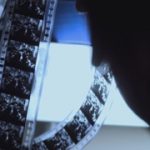

Yasmine graduated from Tel Aviv University’s film studies program. Her previous films include “Zohar,†a short about a tomboy, adolescence and her teenage suiters. She is working on a documentary, The Lost Love Diaries, about a mother and daughter, as they translate old diaries written between Ellis, the mother, and her former lover, Bernie, while in hiding during WWII. As they make progress in their work, uncovering fascinating historic details, they set out on a journey to find out what ever happened to Bernie.
“Chicken Heads†is a short from Deir Bzee’ in the Palestinian Territories and directed by Bassam Jarbawi. In it, a young boy is charged with taking care of the goats and a horned gazelle. In an effort to protect the reputation of the gazelle, he incriminates his pet dog in the death of a goat, which spells bad news for the dog’s future. In “My Mom Smokes Weed,†a humorous short by Clay Liford, a nervous uptight young man, played by Nate Rubin (think Michael Cerra, but cooler), must help his mother score some weed to satisfy her cravings for pot. Liford, a Dallas, TX filmmaker was inspired by his mother, who at age 77, still has a hunger for herb. In 2002, he actually had to go with her to score some from a new South Florida distributor.
One of the hottest tickets at the festival, which consistently had waiting list lines in the hundreds was “Catfish,†directed by Ariel Schulman. The documentary follows the director’s brother, Yaniv “Nev” Schulman, 24, a photographer, who decides to meet 8 year old Abby Pierce and her family in rural Michagan, with whom he has had an online email relationship. Many attendees thought it was the best film of the festival, and passionately pleaded that no one tell anyone anything about the film or its premise, for fear of ruining its impact. Others felt that the film was just too perfect and so far-fetched, that they could not believe that it was a factual documentary, and thought that it was staged and a deception.
But one can say the same thing about “Fix ME,†a documentary film from Palestine by Raed Andoni. It’s tagline is “Life in Ramallah… sure keeps us occupied.†It is a humor filled documentary about 20 psychotherapy sessions with the filmmaker and his therapist, in an effort to heal him of his year long headache. Andoni is best known in the US as one of the producers of Ra’anan Alexandrowicz’s 2001 documentary, “The Inner Tour,†in which nearly two dozen Palestinians go on a three day sightseeing tour of Israel. Andoni, who spent a year in an Israeli prison after high school graduation, tells his therapist that he is not very sociable, is impatient, prefers boredom to engagement, and desires to be apart and separate at group gatherings. Andoni wants to have absolute freedom, but societal obligations exert intense pressure. Driving through the streets of Ramallah in his BMW, he passes a billboard from Canadian Club that implores “Be Yourself.†In this scene as in other humorous one, such as driving backwards or with flour spilling from his truck, he blurs that which is documentary, and that which is staged for humorous effect.


Shabbot
After a quick drash, and blessings over the wine and high altitude challot (it’s the water that make them great), Kevin Asch, the director of “Holy Rollers,†was invited to say a few words. He was followed by leaders of the Sundance Institute who discussed their upcoming Sundance Lab workshops for high potential filmmakers in Israel. This news was followed by a few words from Yael Herzonski, the Israeli director of “A Film Unfinished,“ a Germany/Israel co-produced documentary about found, Nazi-directed film footage from the Warsaw Ghetto.


Footage from a film unfinished
A decade after the end of WWII, East German archivists discovered a secret vault in the forest; it was filled with film canisters. Among the canisters was a nearly one hour film titled, “Das Ghetto 1942.†It was a rough first draft cut of a film about The Warsaw Ghetto. There were no notes or soundtrack. The SS filmmakers’ intentions are no longer known. It is a film unfinished.
The found footage, in four small reels, was used by archivists and documentary filmmakers over the past several decades to show what life was like in the Warsaw Ghetto. The images were used in various documentaries and accepted as documentary reality. But there was just one small problem with that. It was a cinematic deception. The Nazis had STAGED nearly all the scenes.
Hersonski’s documentary shows this Nazi film in its entirety for the first time. Remarkably, a reel of outtakes was found. It shows staged takes from various angles, and accidentally catches glimpses of SS cameramen in some scenes. The Nazi footage shows “wealthy Jews†as well as dead bodies and beggars. A scene that I thought was a crowded street scene turned out to be a staged scene in which hundreds of ghetto residents were placed on a street and then Jewish policemen were ordered to disperse the crowds. The chaos was captured on film, take after take after take. All staged.
In another scene, three rabbis arrive at the office of Adam Czerniakov, the head of the Ghetto’s appointed Judenrat council, to petition him on an issue. A peculiar, lit menorah sits on his desk, as if Jews use menorahs for reading lights. But it was a staged scene; an actor played Adam Czerniakov. How did Hersonski know the scene was a total fabrication? Because Czerniakov’s actual diaries, which were found after the war, detail how the SS filmmakers arrived, took over his offices and his apartment, and filmed throughout the Ghetto in May 1942. Three month’s later, Adam Czerniakov committed suicide after hiding the diaries; the Nazis had started the Ghetto’s final liquidation. Many were sent to Treblinka.
The documentary is produced by Noemi Schory and Itay Ken-Tor. Schory is a celebrated Israeli film producer and head of film studies at the Beit Berl College of Arts in Kfar Sava, outside Tel-Aviv. Her husband directs the Israeli Film Fund.
In the film, Hersonski screened the film to survivors of the Ghetto. We watch them as they watch the film. But, breaking away from Holocaust film tradition, Hersonski does not ask them for their testimonies, rather she wants them to see if they recognize anyone in the footage that they know. Many of them recall seeing the Nazi film crews, and comment on the staged scenes.
Hersonski’s grandmother was a survivor of the Warsaw Ghetto. After her grandmother’s death four years ago, Hersonski searched for materials that could tell her grandmother’s story. She heard of the archived footage and was stunned by its images. This began her project to illuminate the fraudulent footage and explore its value as a testimony. Although the subjects in the film are being forced to act out the scenes, their eyes tell a different story to the camera. Hersonski said, “The images speak their own testimony. We are learning about the victims mainly through the images taken by the perpetrators. This was not an easy journey to make this fim and to watch these images every day for a year. I wanted to present it as a powerful documentation. Even though it is staged, the gaze and eyes of the people being filmed express the truth that cannot be denied by the cinematic manipulation. The ‘frame’ of the footage is limited, but we use the survivors, the diaries, the transcripts of the interrogations of the former SS cameramen from the 1970s, and we were able to make the frame of this film wider.â€
“A Film Unfinished†received the World Cinema Documentary Editing Award at the 2010 Sundance Film Festival’s awards ceremony.
Finally, I find that it has been my lucky habit to find the best film on my last day in Park City. In years past, these have included seeing “Hamlet II†and “Napoleon Dyanmite.†This year was no different. I saw “Boy,†a bittersweet New Zealand comedy starring, written, and directed by Taika Waititi. Mr. Waititi, a prominent Maori comedian in his native New Zealand, and the filmmaker of “Eagle vs. Shark,†sets the tale in his hometown of Waihu Bay in the Maori tribal areas. It is a story akin to a kiwi “Napoleon Dyamite,†in which an 11 year old boy is left to fend for his younger brother and even younger cousins, when his grandmother is called away from town. His mother died seven years ago, and his father is in prison. When his father shows up with his awkward criminal gang of two, his son, “Boy,†tries to reconnect with humorous results. An added insight? The director, Taiki Waititi, also has the surname of “Cohen,†for he is … yes, you guessed it, half Maori and half Jewish.





